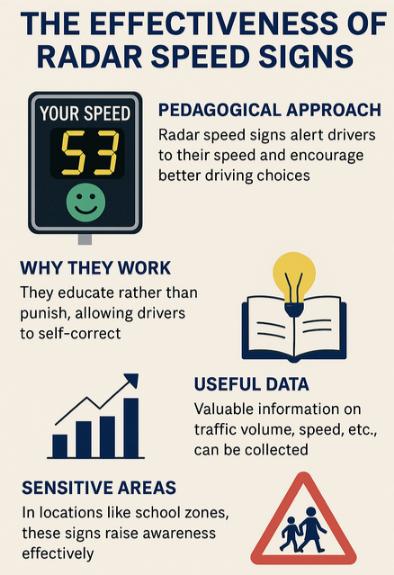In recent years, there has been a noticeable shift in how we approach road safety. While traditional methods like speed bumps and surveillance cameras continue to play their role, a new player has entered the game: radar speed signs.
These dynamic, interactive devices are not only effective but also educational, helping to change driver behavior in a sustainable way.
Rather than punishing drivers outright, pedagogical radars work by alerting them in real time to their speed and encouraging better driving choices. It’s a subtle psychological nudge (showing a green smiley when you’re within the limit, or a red frown when you’re no) that speaks directly to our sense of responsibility. This gentle approach proves far more effective in many scenarios than harsh penalties, especially in urban areas, school zones, and residential neighborhoods.
One of the most widely used versions of this technology today is the Evolis Radar Speed Sign, known for its user-friendly interface and high visibility.
These signs don’t just display a number : they create a small interaction between the driver and the road environment. This interaction builds awareness, trust, and immediate feedback, which are key in reducing speed and improving road safety.
Why They Actually Work ?
Unlike fixed radars, which are often associated with fines and a negative image, radar speed signs aim to educate rather than punish. They give drivers the chance to self-correct. And studies have shown that this method significantly reduces speeding, especially when drivers are reminded in a non-aggressive way.
These signs also collect valuable data, like traffic volume, average speed, and time of passage. This information is extremely useful for city planners and local authorities, helping them understand traffic patterns and improve infrastructure. And since the signs are easily movable, they can be adapted to various problem areas ; making them a flexible solution for both short- and long-term road safety strategies.

Radar speed signs
A Better Approach for Sensitive Areas
Radar speed signs are especially beneficial in places where speed control is vital but harsh measures are not ideal, think near playgrounds, pedestrian crossings, hospitals, or bicycle lanes. In these areas, raising awareness is more effective than instilling fear. Drivers are much more likely to slow down when they feel they are being guided rather than punished.
In addition, these signs contribute to a more respectful driving culture. Instead of treating motorists like criminals, they treat them like responsible adults capable of making the right choices. This subtle shift in tone can change behaviors long-term.
Looking Ahead
As cities evolve toward smarter and safer urban environments, the use of intelligent and adaptable traffic-calming tools like radar speed signs will only grow. They are cost-effective, easy to deploy, and appreciated by both drivers and residents. When we think of safer roads, it’s not just about enforcement, it’s also about education, engagement, and empathy.
Pedagogical radars show us that safety doesn’t have to come through fear. Sometimes, a simple messag, displayed at the right time and in the right way, is all it takes to make our streets safer for everyone.